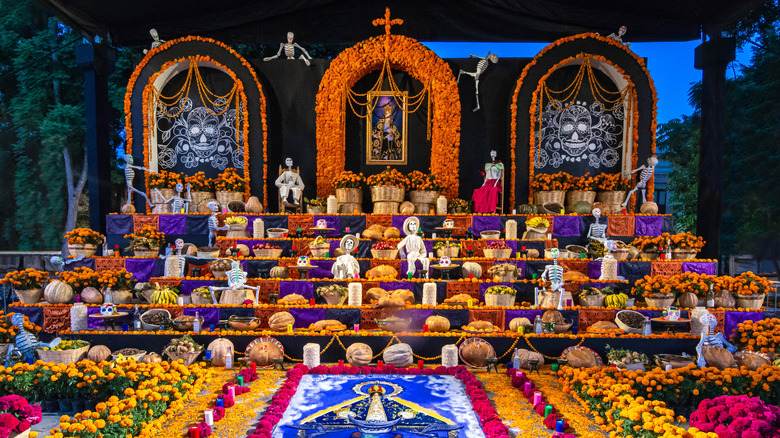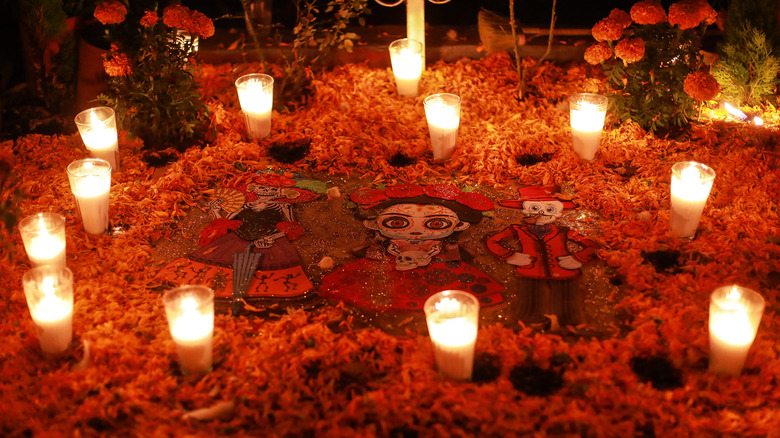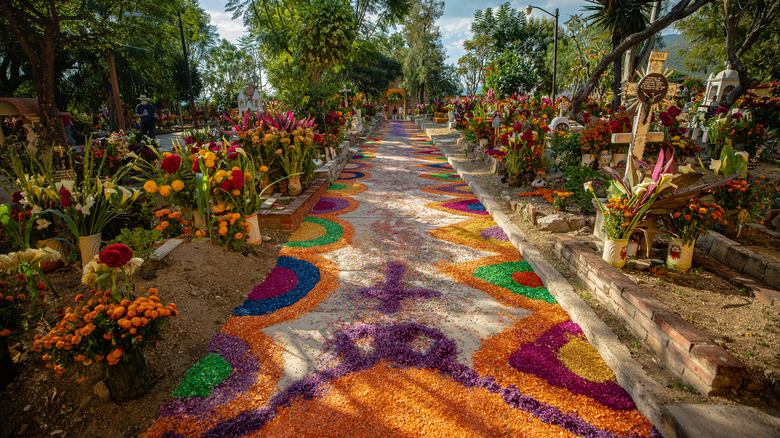Day Of The Dead In This Mexican City Rivals Mardi Gras In New Orleans
Mardi Gras in New Orleans is world-renowned for its vibrant parades, lively music, elaborate costumes, and its overall exuberant atmosphere. But there's another equally fantastic celebration happening south of the border known as Día de los Muertos (or Day of the Dead) in Oaxaca, one of Mexico's safest destinations. For more than two days, the city pulses with life, barely pausing as it honors the ancient tradition. From lively parades with marching bands and dancers to the colorful altars, flavorful food, and cemeteries adorned with marigolds, this celebration is truly one of a kind.
Long before the Spanish arrived in Mexico, the Zapotec, Toltec, and Aztec civilizations celebrated the Day of the Dead. For these cultures, death wasn't seen as an end but as the beginning of a journey. They believed that after death, souls embarked on a 9-stage journey through the underworld, eventually finding peace. Death was revered as a natural and significant part of life. According to their traditions, on October 31st, the boundary between the living and the dead dissolves, allowing spirits to return to visit their loved ones for 48 hours. First, the spirits of the young arrive, followed by the elder spirits as the celebration draws to a close. While Día de los Muertos now incorporates Catholic symbols introduced by the Spanish, it remains at heart a celebration of eternal life, love, and connection across generations.
Spending Day of the Dead in Oaxaca
Oaxaca, a state in southwestern Mexico, is well-known for its exquisite cuisine, breathtakingly clear beaches, and its magical Día de los Muertos festival. Official festivities kick off on November 1st and last through November 2nd, but the city comes alive days before. There are myriad experiences to immerse yourself in. One unforgettable activity is the Oaxaca Marigolds Field Experience, where you'll learn about the importance of marigolds in guiding spirits back to the living world. You'll wander through vibrant fields and discover this floral tradition in a way that will stay with you forever. Another must-try is the Oaxaca Makeup and Pro Photo Experience, where you can respectfully take part in the face-painting tradition with locals, gaining an insider's view into this important aspect of the celebration.
For those drawn to food, the Mitla & Pan de Muerto Experience offers the chance to make pan de muerto, a traditional Day of the Dead bread, with the locals in Mitla, a town known for its deep connection to the ancient underworld. It's an opportunity to explore Mitla's rich culture and enjoy a hands-on culinary adventure.
Immerse yourself in the authentic Oaxaca experience
For those looking for more hands-on experiences, the Day of the Dead Cooking Class & Market Experience allows you to learn how to make classic Day of the Dead dishes, like mole negro and tamales. This adventure takes you to a local market where you'll shop for fresh ingredients, then learn how to prepare these iconic meals — skills you can bring home to recreate for future Día de los Muertos celebrations.
When seeking a full cultural immersion, G Adventures' Day of the Dead Experience in Oaxaca offers a 7-day, all-inclusive tour where you can join the festivities, experience the region's artistic culture, savor Oaxaca's famed cuisine, and explore ancient ruins. Another option, G Adventures' Oaxaca to Puerto Escondido Day of the Dead Tour, begins with four days of parades, macabre costumes, and market visits in Oaxaca City, before winding down on the beaches of Puerto Escondido for some rest and relaxation.
Whether you're drawn to the art, food, culture, or simply want to experience an unforgettable festival, Día de los Muertos in Oaxaca rivals the grandeur and spirit of Mardi Gras in New Orleans. Both celebrations are a testament to the joy of life, even in the face of death, but Oaxaca offers a deeper, more soulful experience grounded in a thousand-year-old tradition that honors life, death, and everything in between.


